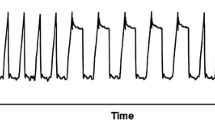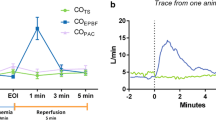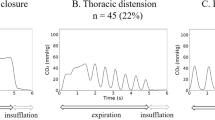Abstract
To evaluate the potential of trend monitoring of end-tidalPco 2 (Petco 2) to detect pulmonary embolization, the capnograms of 24 mechanically ventilated patients were monitored during simulation of 1-ml pulmonary embolization by inflation of the balloons of their pulmonary artery catheters. Within 1 minute of balloon inflation,Petco 2 showed an exponential decrease to a new equilibrium. This response is characteristic of a CO2 wash-out curve produced by a step increase in dead space. Because of a steady baseline, the depression of the trend line during balloon inflation was apparent to a naive reader repeatedly in 20 of the 24 patients (sensitivity, 85%; specificity, 94%; positive predictive value, 98%; negative predictive value, 89%), despite a small mean decrease inPetco 2 (2±1.97 mm Hg). ThePetco 2 trend curve did not reliably allow detection of balloon inflation in 4 patients whose capnograms were poorly formed. In conclusion, during constant ventilation,Petco 2 trend curve monitoring might provide clinically useful “on line” information regarding pulmonary embolization.
Similar content being viewed by others
References
Saltzman HA, Alavi A, Greenspan RH, et al. Value of the ventilation/perfusion scan in acute pulmonary embolism. JAMA 1990;263:2753–2759
Ceraldi CM, Schabel SI, Waxman K. Normal ventilation/perfusion lung scan in a patient with proven pulmonary embolus. Crit Care Med 1990;18:577–578
Bone RC. Ventilation/perfusion scan in pulmonary embolism. Editorial. JAMA 1990;263:2794–2795
Severinghaus JW, Stupfel M: Alveolar dead space as an index of distribution of blood flow in pulmonary capillaries. J Appl Physiol 1957;10:335–348
Vereerstraeten J, Schoutens A, Tombroff M, et al. Value of measurement of alveolo-arterial gradient of PCO2 compared to pulmonary scan in diagnosis of thromboembolic pulmonary disease. Thorax 1973;23:306–312
SPSS/PC + V2 for the IBM PC/XT/AT & PS2. Base Manual. SPSS, Inc. Chicago, IL, 1988
Gaddis GM, Gaddis ML. Introduction to biostatistics: part 3, sensitivity, specificity, predictive value, and hypothesis testing. Ann Emerg Med 1990;19:591–597
Chopin C, Fesard P, Mangalaboyi J, et al. Use of capnography in diagnosis of pulmonary embolism during acute respiratory failure of chronic obstructive pulmonary disease. Crit Care Med 1990;18:353–357
Eriksson L, Wollmer P, Olsson C, et al. Diagnosis of pulmonary embolism based upon alveolar dead space analysis. Chest 1989;96:357–362
Fisher SR, Duranceau A, Floyd RD, et al. Comparative changes in ventilatory dead space following micro and massive pulmonary emboli. J Surg Res 1976;20:195–201
Marshall KW, Bedford RF. Use of a pulmonary-artery catheter for detection and treatment of venous air embolism. Anesthesiology 1980;52:131–134
Author information
Authors and Affiliations
Rights and permissions
About this article
Cite this article
Carroll, G.C. Capnographic trend curve monitoring can detect 1-ML pulmonary emboli in humans. J Clin Monitor Comput 8, 101–106 (1992). https://doi.org/10.1007/BF01617426
Received:
Revised:
Accepted:
Issue Date:
DOI: https://doi.org/10.1007/BF01617426




